The Contax T is a compact rangefinder introduced in 1984. It was the first in what would become a line of premium point-and-shoot cameras, a segment pioneered by Contax. It was also the first Contax camera developed since acquisition of the brand by industrial giant Kyocera (formerly Kyoto Ceramic Company), and they aimed to make a splash.
Design
For the Contax T’s titanium-clad body, painted black or silver, Kyocera enlisted the aid of Porsche Design, the same firm behind the first Contax SLR (the RTS) a decade prior. Like all Contax cameras, its defining feature was utilization of a Carl Zeiss lens, in this case a classic Sonnar design with a focal length of 38mm and maximum aperture of f/2.8. The finishing touch, showcasing Kyocera’s expertise in materials, was a synthetic ruby shutter release (which I guess is how a ceramics company shows off).
In the hand, the Contax T exudes quality, with a reassuring heft belying its diminutive dimensions (about the size of a pack of cigarettes). The design emphasizes compactness and portability, with a drawbridge-like panel that folds up and provides protection for the collapsible lens, as well as the front rangefinder and viewfinder windows. Both the film rewind crank on the top plate and the film advance lever in the back are recessed, sitting flush with the body and allowing for easy slippage into and out of pockets with minimum chance of catching. It’s a nice touch.
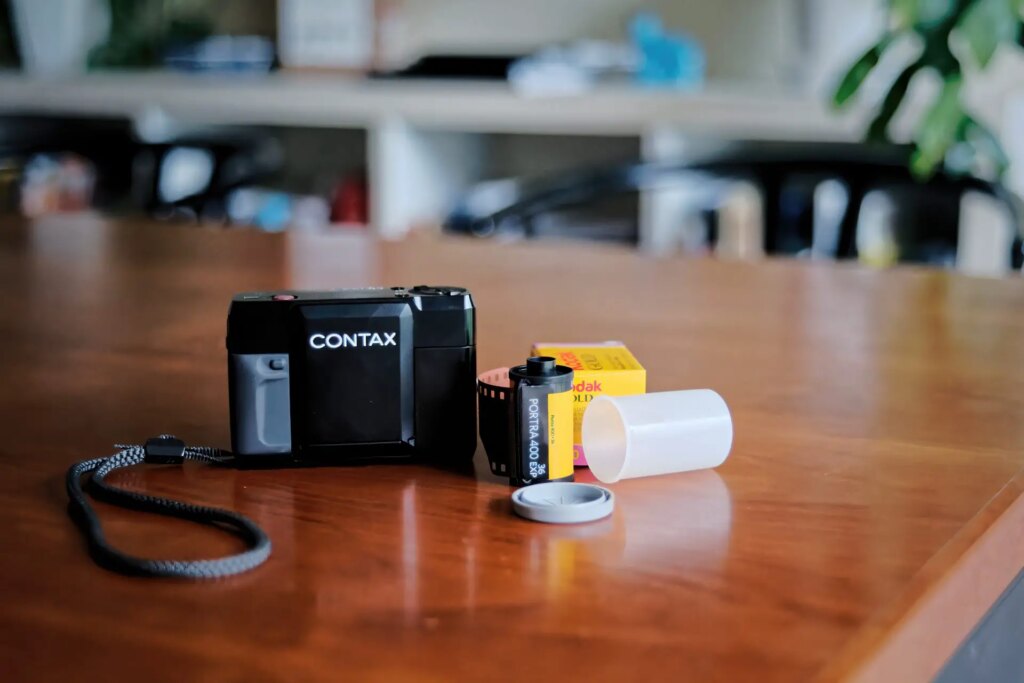
Operation:
Meter & Focus
Functionally, the Contax T offers aperture priority auto exposure, with metering by an SPD cell mounted on the front of the lens. There is a ring for manual focusing, and one for selection of aperture (f/2.8-22). Shutter speeds are camera selected and stepless from 8-1/500 seconds. There are no filter threads on the very small, collapsible lens.
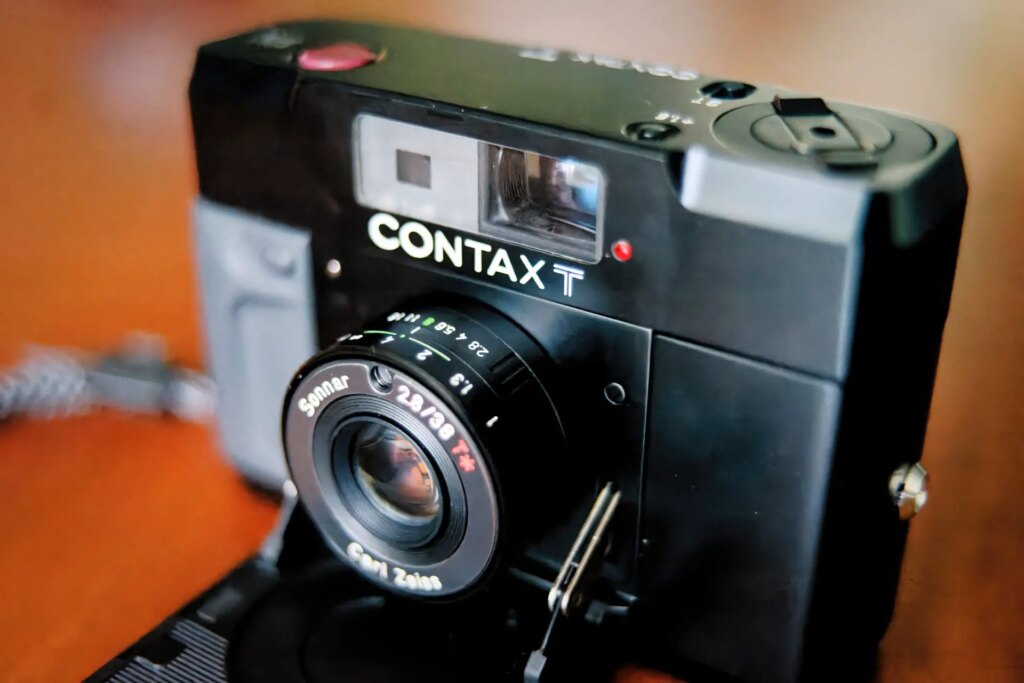
Top Plate
On the top plate, there is a “backlight compensation button” which provides +1.5 stops of exposure compensation when pressed, but there is no more granular level of control offered. There is also a self-timer button, if you’re into that sort of thing. There is a small LED frame counter next to the shutter release. ISO is user selected from a range of 25-1000.
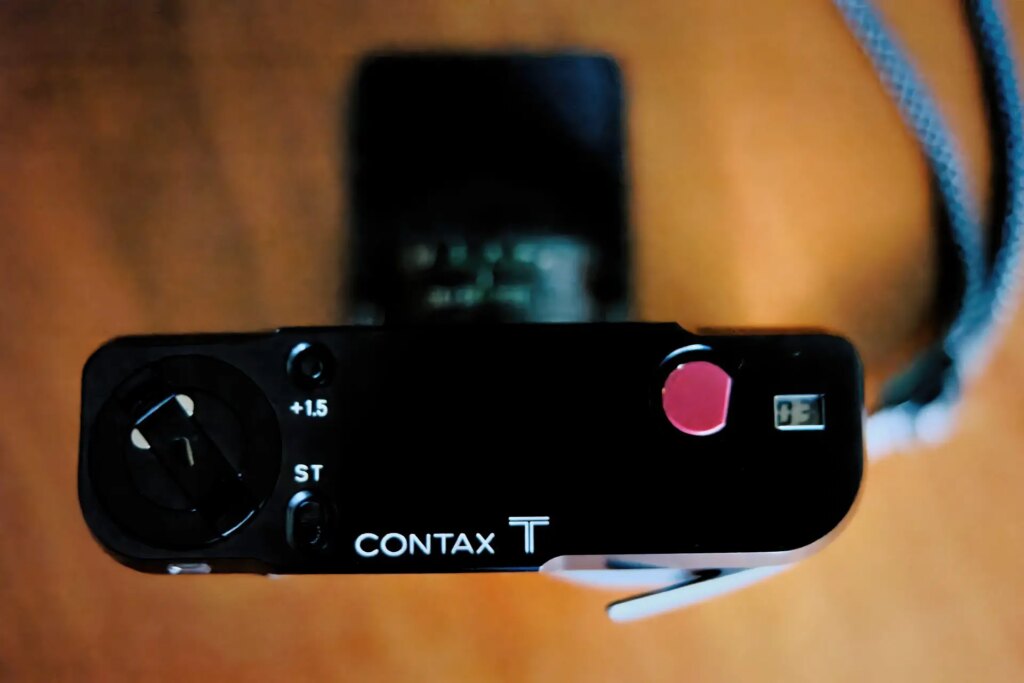
Viewfinder
In the Contax T viewfinder, there are bright frame-lines for composing, as well as a diamond-shaped rangefinder patch which provides for coincident image focusing. On the right side there is a 4-LED exposure display which seems over-simplified at first, but which is actually quite elegant, in my opinion. The display shows only three shutter speeds: 500, 125, and 30 (from top to bottom). If a red LED blinks above 500 (the camera’s maximum shutter speed, remember), that indicates overexposure. A blinking light between 500 and 125 indicates correct exposure. A blinking light between 125 and 30 also indicates correct exposure, and also lets you know that you are below the maximum flash sync speed of 125. Finally, a flashing light under 30 indicates a selected shutter speed anywhere between 8-1/30 seconds, and warns you of possible camera shake and/or underexposure. It sounds terribly confusing, but really you just need to try to keep one of the two middle LEDs lit as much as possible.
Flash
Speaking of flash, the Contax T is paired with a dedicated unit, the T14 AUTO. This screws on to the side of the camera by thumb wheel, has its own power button, and a flash ready lamp on top. You also get a ready indicator in the viewfinder by way of blinking of the red exposure LED – just remember to keep your shutter speed below 125, or the flash won’t fire.
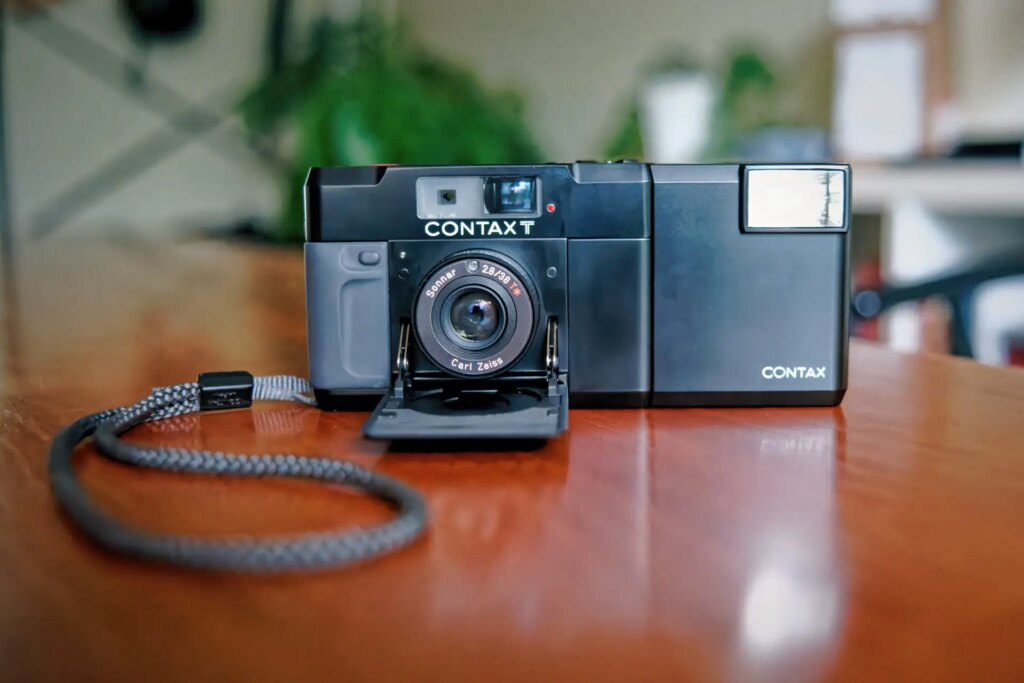
Batteries
The Contax T takes two button batteries (LR/SR44) . The flash takes two AA batteries.
A More Personal History
I bought my first Contax T in 2009. By then, I was about 5 years deep into an obsession with the brand that had started with the purchase and restoration of a 139Q, and had taken me all the way through to the last Contax manual focus SLR, the excellent Aria. The T was a bit of a novelty for me, more of a collector’s check-in-the-box than anything else, if I’m honest. I hadn’t yet warmed up to the rangefinder ethos and saw the T as more of a beautiful (if quirky) object than a serious camera. It fell into disuse and was sold, along with the rest of my beloved film cameras, sometime after.
Perhaps in an effort to right past wrongs and undo old mistakes, I picked up another Contax T this year. This particular copy was a super minty example that I watched on eBay for about 6 months, until the seller lowered his price to a threshold that I could no longer resist. Now, as then, my reaction upon unboxing the camera was the same – I couldn’t believe how small it was, yet stunningly well-built and frankly, gorgeous to behold.
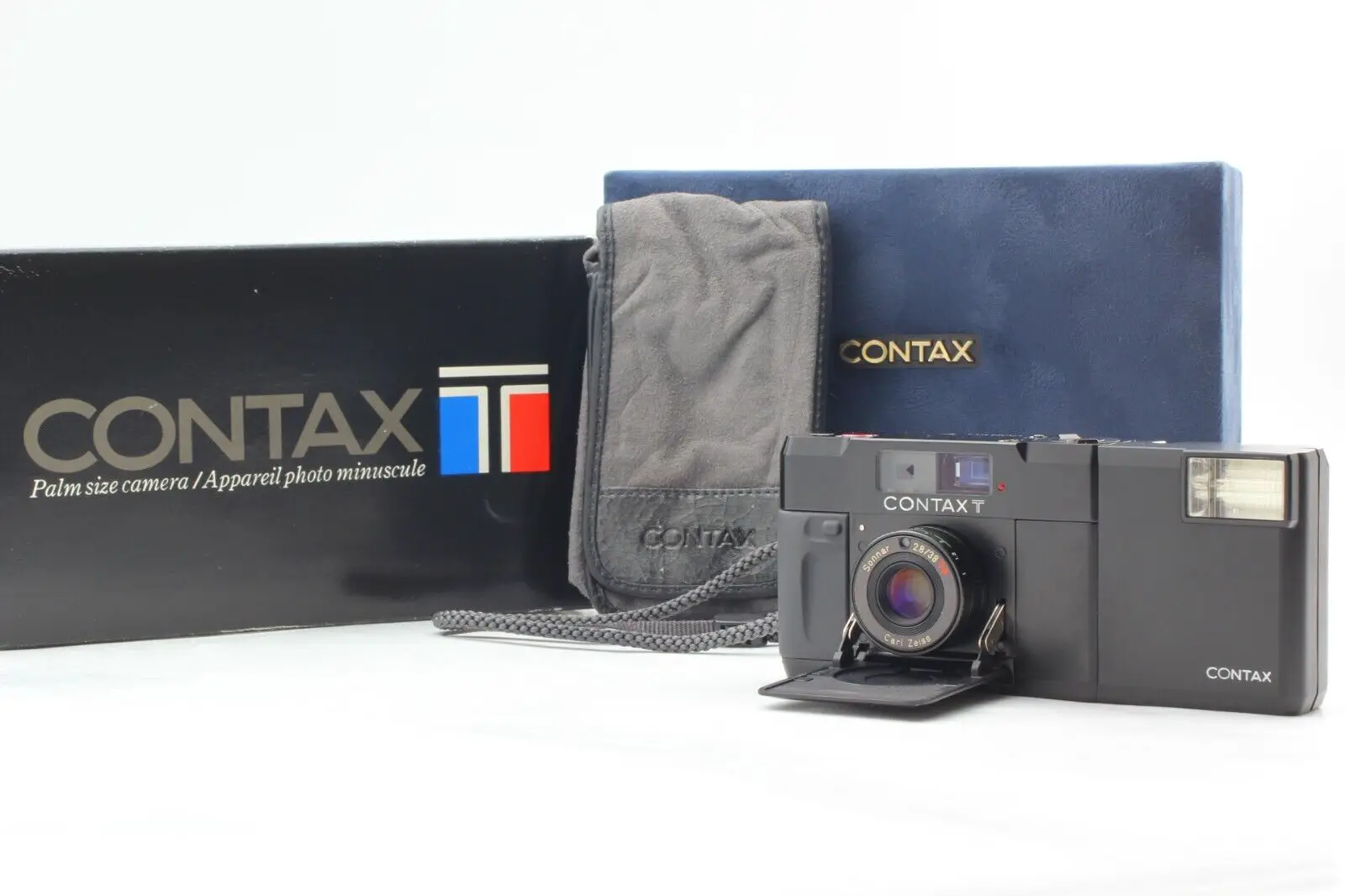
Field Notes
But what’s the Contax T like to use?
In a word, fun – but there are of course caveats. The camera is really and truly pocketable – you could park this thing in the front pocket of your skinny jeans all day long – while simultaneously offering an impressive level of manual control. It stands to reason that the ergonomics would suffer somewhat as compared to a larger camera, and the truth is that the handling is idiosyncratic, to say the least.
For one thing, the drawbridge mechanism borders on being form over function – I mean, I understand that it protects the front of the lens and facilitates its retraction, important functions to be sure, but I feel like a sliding door would’ve been a better choice (indeed, the subsequent T2 and T3 opted for this approach). An advantage of the drawbridge is perhaps mechanical simplicity, especially since it is not motorized, but it does take an extra second or two to deploy, and feels kind of goofy just hanging off the front of the camera while in use. And then you have to sort of reach around it in order to get to the lens for focusing and aperture selection – and, by the way, the lens is tiny and fiddly, but the focusing ring is at least well-damped and the aperture ring is clicked at full stops.
But, you get used to it. For one thing, the lens is brilliantly marked for easy zone focusing. The engraving for f/8 is painted green, and there is a corresponding green dot on the focusing ring – so long as you line both of these up, you should have acceptably sharp focus from 1.7 meters to infinity – not bad for a camera with a minimum focusing distance of 1 meter. This effectively allows you to treat the Contax T as a fixed focus point-and-shoot camera most of the time, but with the ability to override manually for critical focus at any time. It works!
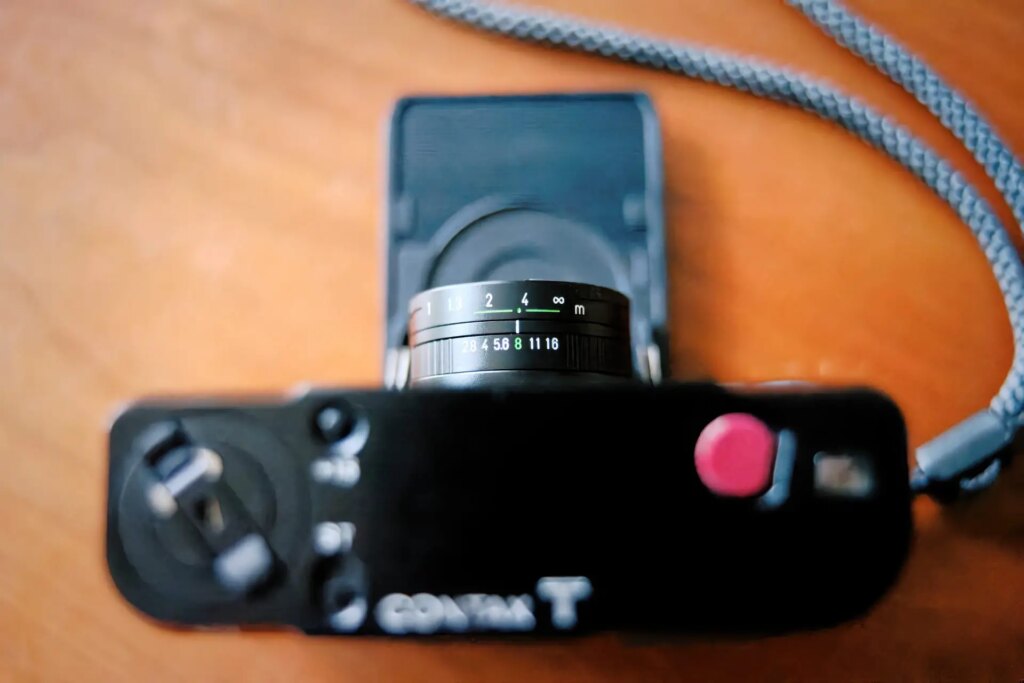
One other thing I love about the Contax T’s handling is the film advance lever. The way it is recessed into the body and sort of integrated into the rubber grip just feels phenomenal. It is grooved in a way that your thumb just slides right under it to release it from the body, and then will stand off until you click it back in. And the action is just buttery smooth. It’s seriously one of my all-time favorite advance levers. If you don’t geek out about film transport, you might not understand.

A gripe that I do have is that the Contax T is prone to rattling when film is loaded. This is not due to the lens or any other internal part of the camera moving around, but rather the film cartridge is just not snug enough in the film chamber when the body cover is in place. I honestly can’t recall if my first T did this or not, but I’ve seen the problem mentioned before on forum posts so I think it’s normal and not limited to this copy. In any case, I think it will be easy enough to fix – probably just requiring a piece or two of strategically-placed foam tape – but it’s a little frustrating that it’s an issue at all, particularly in a camera where fit and finish was otherwise so well attended to.
Some other common niggles:
– The flash housing is plastic, and feels cheap and flimsy compared to the titanium-bodied camera. Not entirely untrue, but I find the flash construction not really objectionable, and I appreciate the lighter weight I guess. When coupled to the camera, I don’t really notice the difference in materials. And, more importantly, who is really going to use a flash with this camera anyway?
– The film loading process is barbaric. Again, a kernel of truth here, and your opinion will largely depend on your experience with different cameras and film loading in particular. Certainly a back-door loading camera is easier than the older bottom-loading design employed here. And the flippy pressure plate will mock you. But I’ve yet to have any sort of film-loading disaster (knock on wood). Incidentally, the process of taking apart the camera really gives you a sense of the scale of the thing – it literally is just large enough to load a film cartridge.
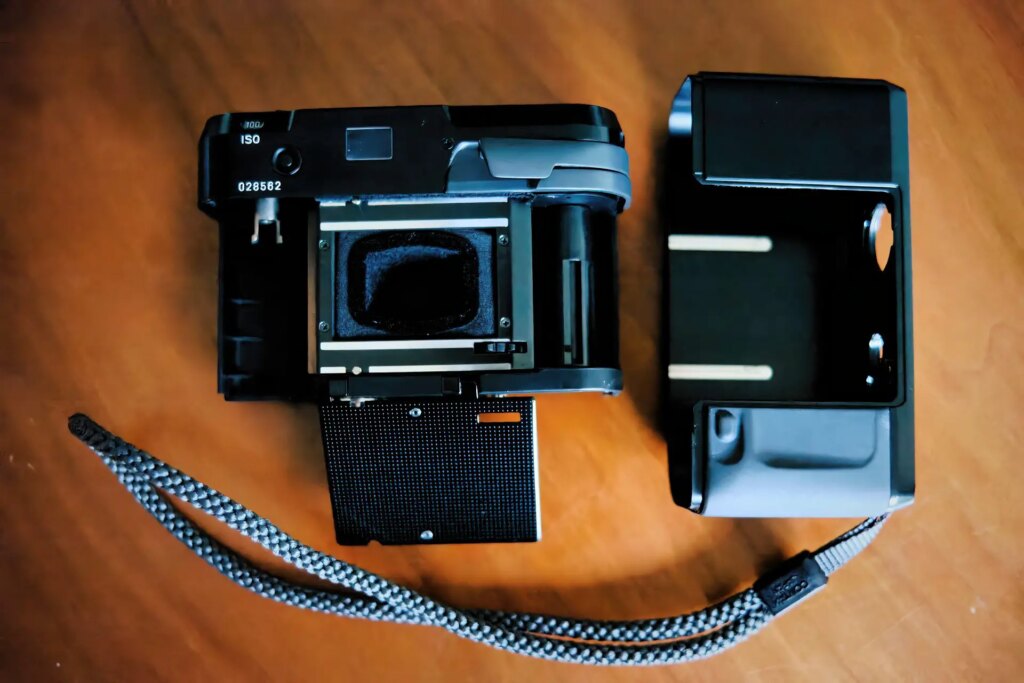
– Doesn’t Kendall Jenner use a Contax T? No, to my knowledge she shoots (shot?) a T2, which is why no one can afford one anymore. T3’s are similarly overpriced. Probably the only thing that keeps T pricing sub-stratospheric is the manual-only focus, which is ironic because a well-kept T will likely outlast the newer autofocus cameras.
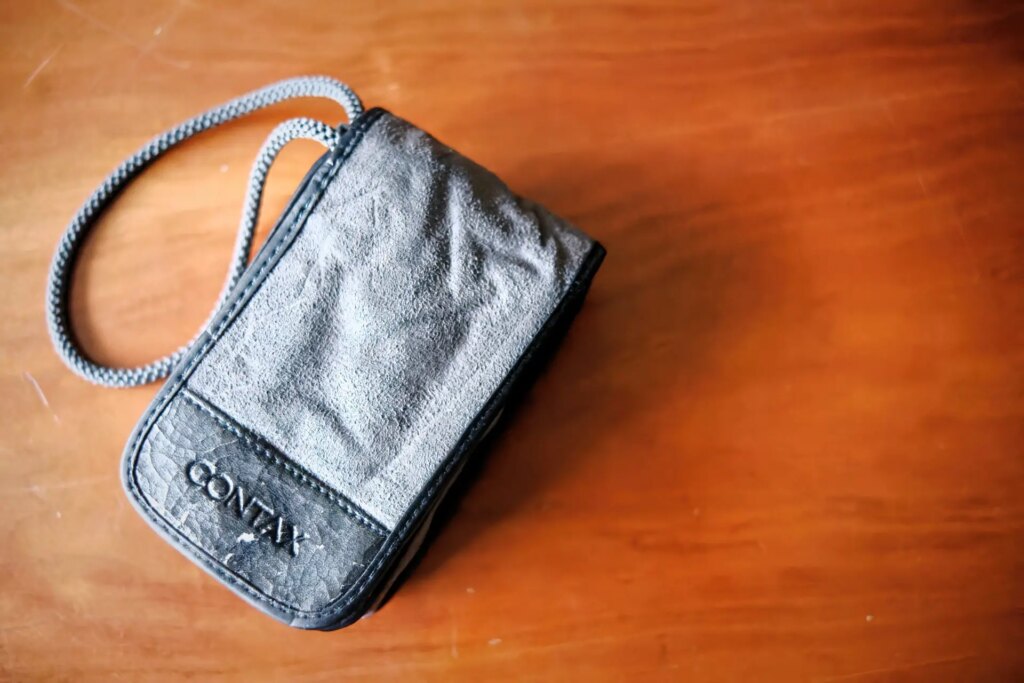
The Photos
Because talking about a camera is worthless if we can’t see what it can do – please enjoy a few snaps taken with my Contax T.
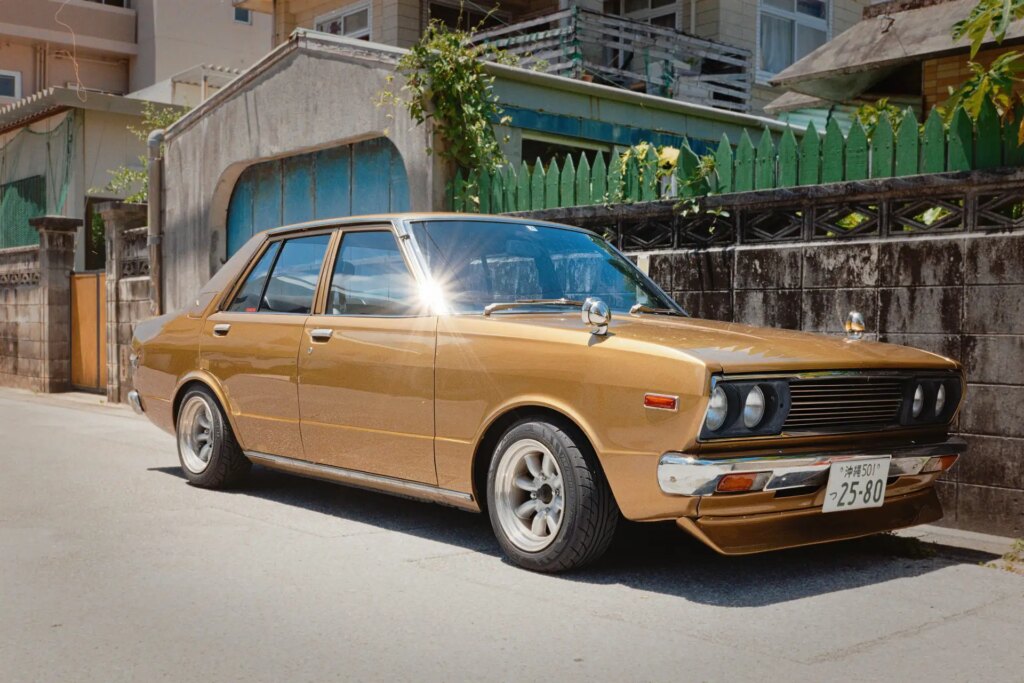


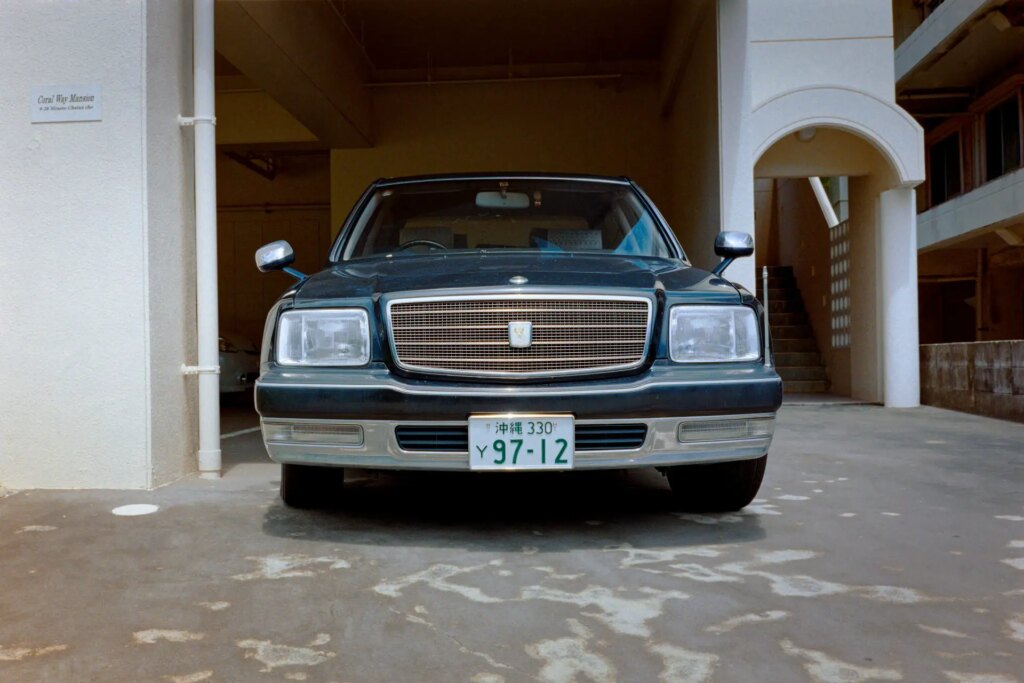
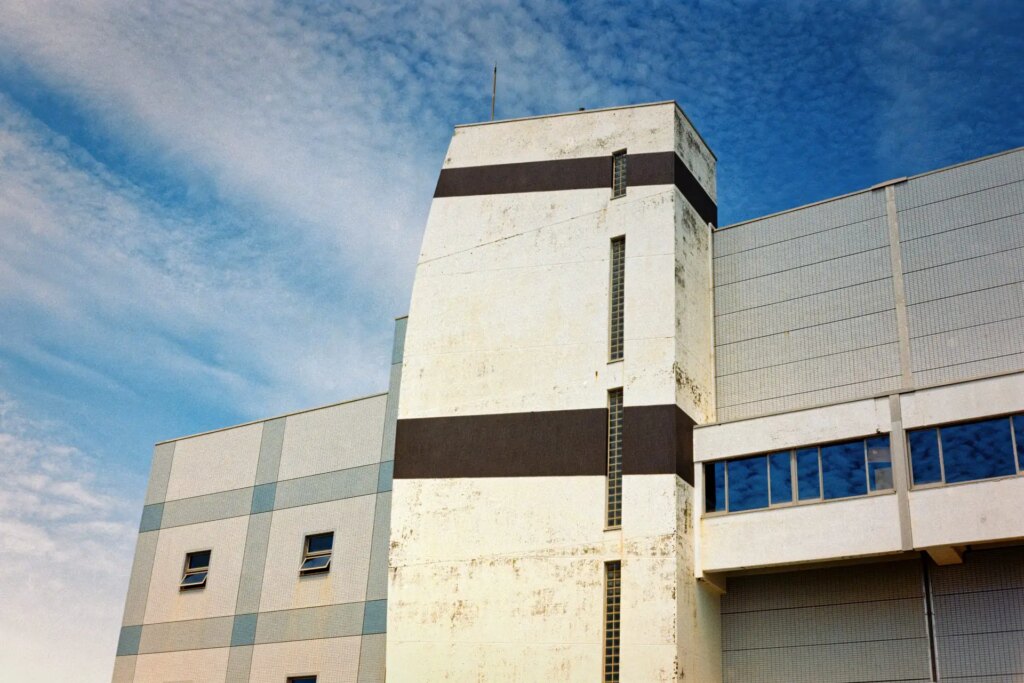
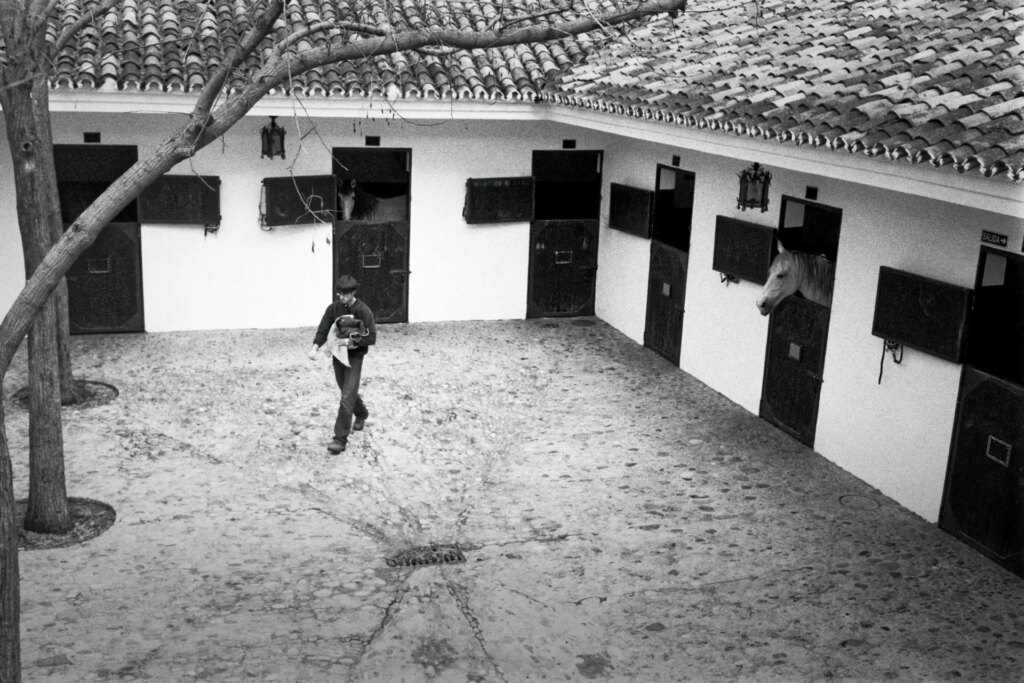
Conclusion
In my humble opinion, the original Contax T is a best-in-class camera. Like anything, its design and execution represent a compromise between competing interests, and should be understood in that context. With this camera, Contax managed to shoehorn a full complement of manual controls into an almost impossibly small body, and they did so with peerless style and sophistication. The ergonomics, while admittedly sub-optimal at times, are simply a function of the compactness. Build quality and materials are first rate. This camera set the standard for what a premium compact camera could be, and remains an exemplar of the segment.
You can find another review of the Contax T on 35mmc here
this/is/grain_frame | bio.site/grain_frame
All work managed under a Creative Commons license (CC BY-NC-ND)
Share this post:
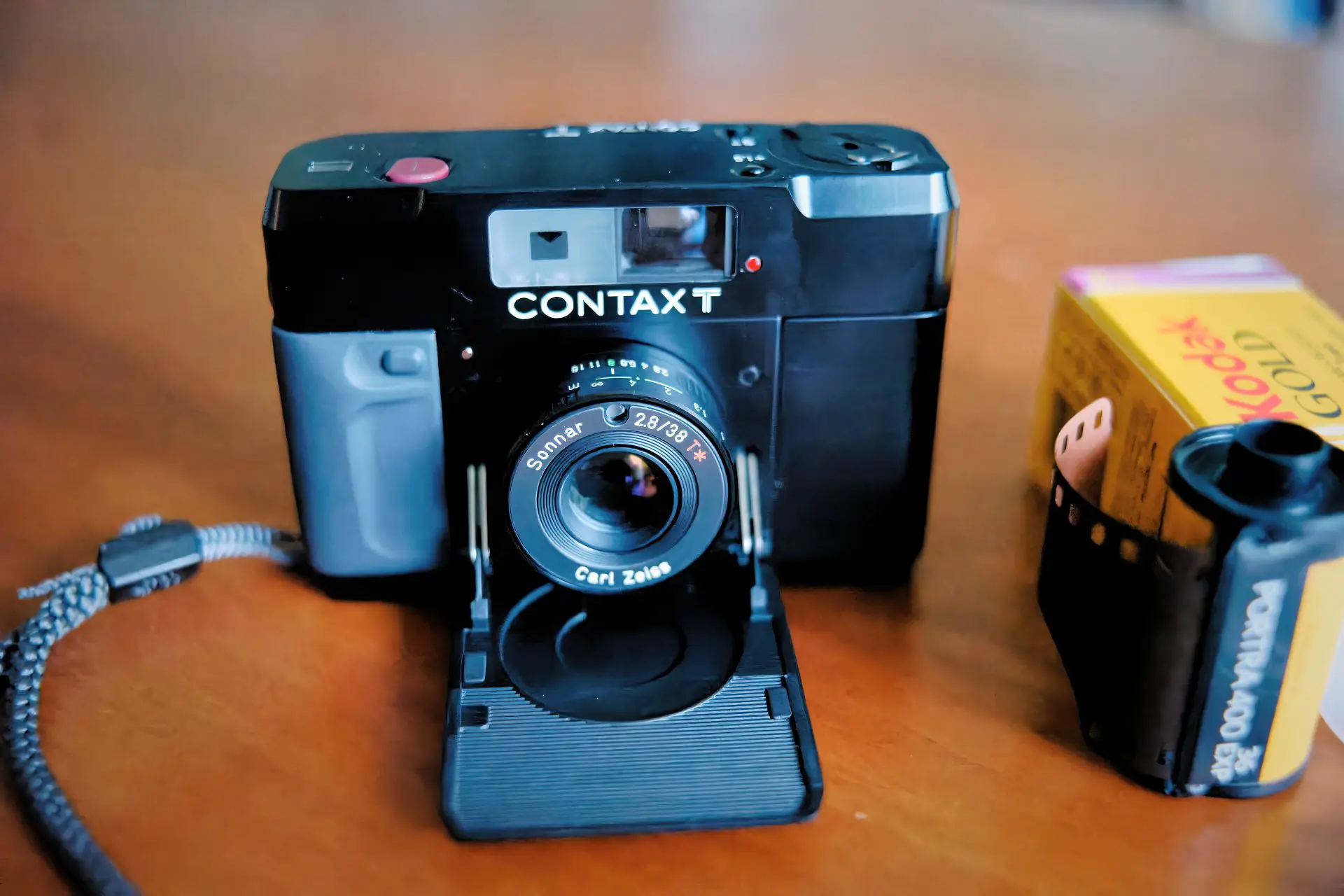
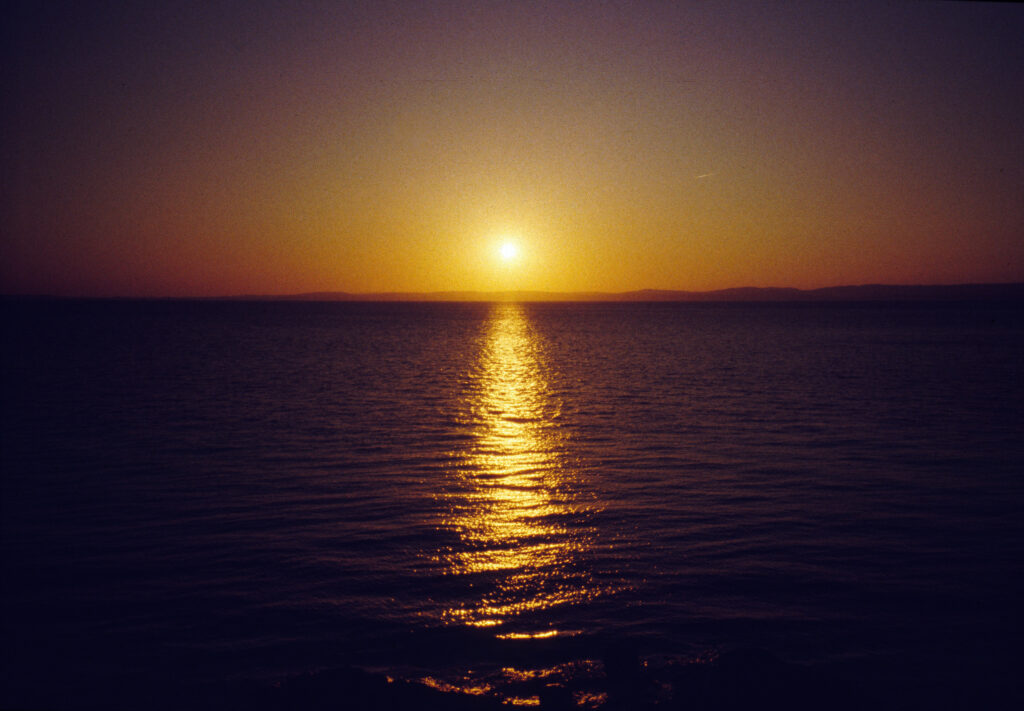

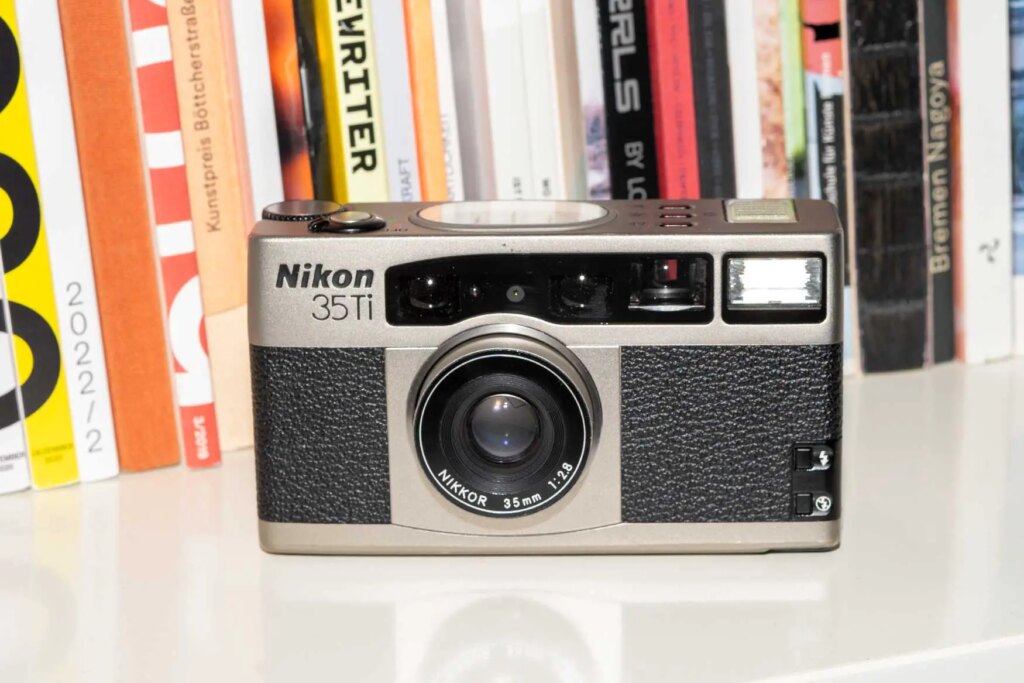
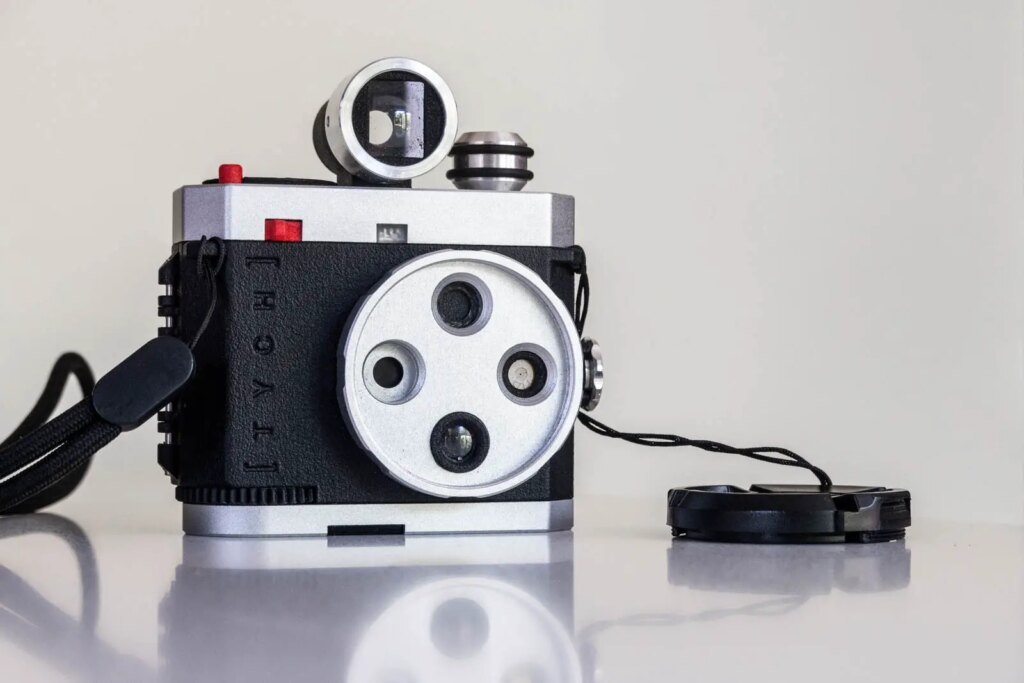




Comments
Adrian Cullen on CONTAX T – The 1st One – A Compact, Manually-Focused Rangefinder
Comment posted: 10/10/2022
Comment posted: 10/10/2022
John Murch on CONTAX T – The 1st One – A Compact, Manually-Focused Rangefinder
Comment posted: 10/10/2022
Brian on CONTAX T – The 1st One – A Compact, Manually-Focused Rangefinder
Comment posted: 10/10/2022
The lens, ergonomics, ISO range, and everything else about them I am a huge fan of.
Maybe i need to find another copy, less abused.
I also have an Olympus XA which although most of the body is plastic, I feel is ultimately a bit sturdier than the Contax T.
Comment posted: 10/10/2022
Eric Norris on CONTAX T – The 1st One – A Compact, Manually-Focused Rangefinder
Comment posted: 10/10/2022
It took me at least three tries to get a working version (finally found one at a camera swap), but now that I have one I love it. Yes, it's zone focusing, but it's similarly small and pocketable and produces great images. I later found the matching Minox flash unit, a dedicated flash almost as large as the camera itself!
Thanks for the review of the Contax!
Comment posted: 10/10/2022
Helge on CONTAX T – The 1st One – A Compact, Manually-Focused Rangefinder
Comment posted: 10/10/2022
It’s even textured and black to work better as such. Turn the camera around in strong sun or with the side blocking sideways sun in portrait mode.
The door is also a nice handle for stabilizing the front of the camera when holding it.
And a kickstand for impromptu timed exposures (on non abrasive surfaces, like the cover of course).
It also gives stability and protection to the lens.
Comment posted: 10/10/2022
Dan Castelli on CONTAX T – The 1st One – A Compact, Manually-Focused Rangefinder
Comment posted: 10/10/2022
Comment posted: 10/10/2022
Eric Rose on CONTAX T – The 1st One – A Compact, Manually-Focused Rangefinder
Comment posted: 11/10/2022
Great article though!
Comment posted: 11/10/2022
Eric Rose on CONTAX T – The 1st One – A Compact, Manually-Focused Rangefinder
Comment posted: 13/10/2022
Comment posted: 13/10/2022
Comment posted: 13/10/2022
Mike on CONTAX T – The 1st One – A Compact, Manually-Focused Rangefinder
Comment posted: 14/10/2022
Comment posted: 14/10/2022
Rajat Srivastava on CONTAX T – The 1st One – A Compact, Manually-Focused Rangefinder
Comment posted: 14/10/2022